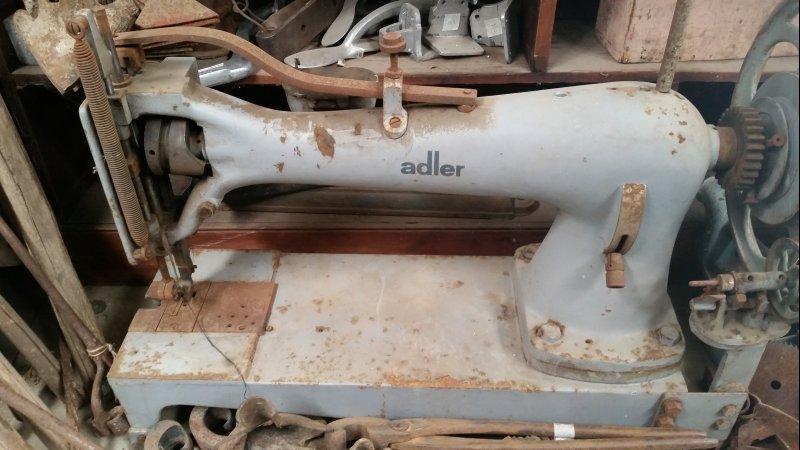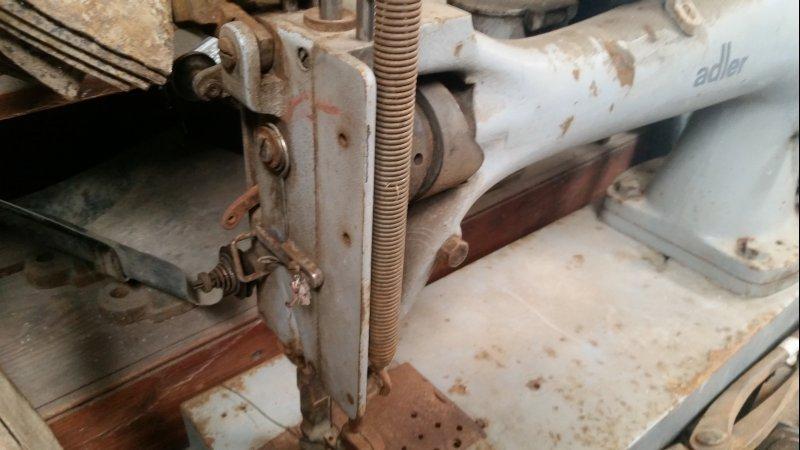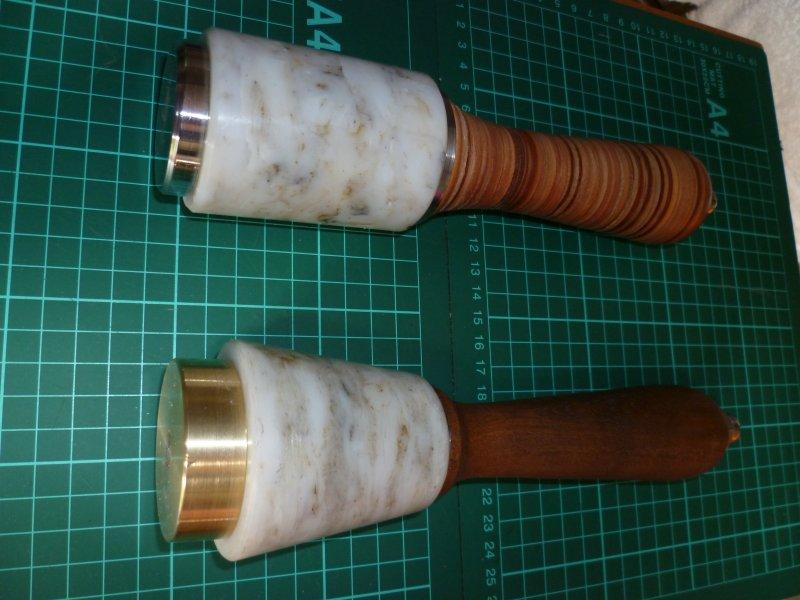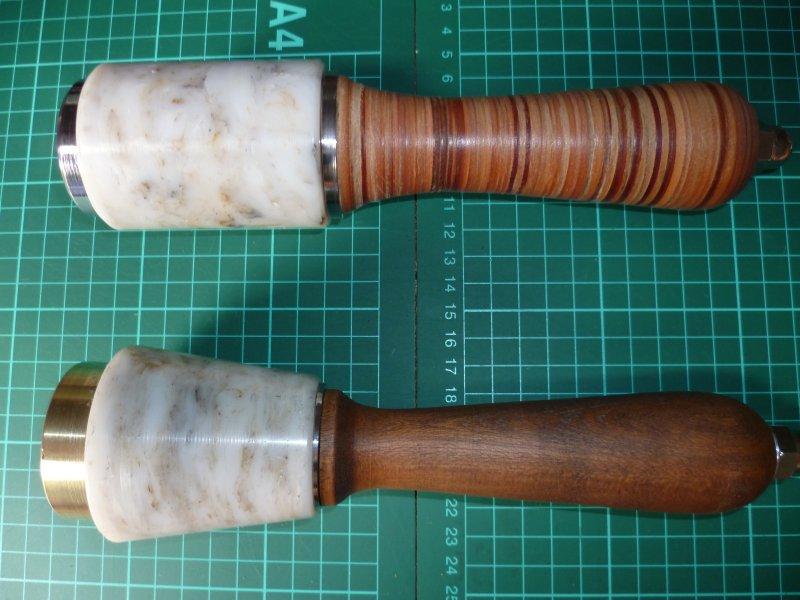-
Posts
4,785 -
Joined
-
Last visited
Content Type
Profiles
Forums
Events
Blogs
Gallery
Everything posted by dikman
-
Instructions.I would think you would have to set it up in the menu as it's likely that it would be turned off by default.
-
If there's no reducer setup, i.e. belt is going directly from the motor to the handwheel and it has been set up correctly then it has to be the settings in the menu system (unless it's faulty, of course). Can you post a photo of the setup pages?
-
GRod, I turned this piece on the lathe to see what it was like, it's ok but could be better. There are obvious small areas, mostly on the bottom, where the mass hasn't fused properly. I think what probably happened is that because I was slowly building up the "layers" in the tin the bottom area was slowly losing heat as I got closer to the top. By using an oven the tin is constantly returned to the heat source so the mass retains the heat better. My method using the oven was to place an enamelled tray in with the tin on it, put some pieces of plastic in the tin and also put some on the tray to melt, when I removed the tray I squashed down the plastic in the tin and used a paint scraper to lift the stuff off the tray and put it in the tin then squashed that down. Then repeat the process, and repeat and repeat......Don't put too much in at a time or it can take a while to melt.
-

Difference between using a Larger Pulley vs. Speed reducer?
dikman replied to tofu's topic in Leather Sewing Machines
rchaven, nice job, yet another variation on building a speed reducer. There is no doubt that using a speed reducer will give slower speeds than just replacing the handwheel with a larger pulley but it just depends on what a person wants and which is the easiest (cheapest?) method to use. One of mine is down to 1 stitch every 2.5 seconds, a bit extreme perhaps, but.......... Oh, and because you're new here you obviously won't be aware but there have been a few posts about speed reducers and needle positioners and basically they don't work well together! -
GRod, sometimes you can find old pewter drinking vessels at thrift shops which might be suitable (not too big and often have a conical-type shape). We once had a set of aluminium drinking cups that were a similar shape. You can use a gas torch to melt the HDPE but you have to be careful as it can scorch the stuff, and while it will still work it looks a bit unsightly. The trick with molding this is to keep pressing it down to force it together and work out any air bubbles. Another chap on youtube uses a sandwich toaster thingy, one that is flat inside, and uses non-stick cooking sheets to stop it sticking. Great for flat sheets, but I guess you could roll the sheet into a cylinder and then force it into a mold? I've started looking at he bottom of plastic containers now, checking for the #2 (or 4) code! Bit of a worry.......
-
For anyone else wanting to try melting plastic to make anything, my latest "test" results. I tried making another maul head and used the fine turnings from my previous one. Now, this "should" have melted easier and fused better according to my reasoning. Unfortunately it tended to be somewhat spongy and took a lot of pressure to squeeze it together, so while it worked I'm not overly happy with the result (plus the plastic appeared to scorch so looks brown). The best results came from using the milk bottles cut up into approx. 3/4" squares. I tried another smaller one, in half a tin, but rather than use the oven I placed a few pieces in the bottom of the tin and used an electric heat gun to heat the plastic until it was transparent, then added more pieces, heated again and so on until the tin was full. Every few layers I used a piece of wood to ram the molten mass down. I then clamped the resultant mass to squeeze it together and left to cool. This was quicker than using the oven and the lump at the end looked pretty good with a fairly uniform white colour and minimal flaws. Like many things, the process looks easy.........until you try it!
-

Difference between using a Larger Pulley vs. Speed reducer?
dikman replied to tofu's topic in Leather Sewing Machines
Simple answer is you don't need one. Don't forget that most machines that people are fitting reducers to only have a 4" handwheel, NOT the 13"/10" that you have. "fabricobble" - good one, a word that is very applicable to my various efforts. Along with the classic "fettle". -

Thread stuck to bobbin when pull out the work
dikman replied to Orrrmygod's topic in Leather Sewing Machines
And going around that pin would certainly cause an increase in thread tension!! -

Thread stuck to bobbin when pull out the work
dikman replied to Orrrmygod's topic in Leather Sewing Machines
I'm curious when you say it's the correct threading. I've checked my manuals for Singer 111 and 211 series, my Seiko and Pfaff 335 (both old and new castings) and none of them show the thread going around that pin. -
Catskin, I figured it's probably a later subclass (not a 2) because of the points you mentioned but the lack of information on these things makes it difficult to know. If I could have checked the foot clearance it might have helped. As my wife said he obviously isn't in a hurry to sell it (she always maintains that when selling something your first offer is often the best).
-
Had another look at it. It wouldn't quite turn over a complete cycle, there seems to be a lot of pressure on the foot. The second foot has been welded together and the hand lever to lift the foot is broken off (!) so I couldn't lift the foot to see how much clearance there is. There's rust around the shuttle area although the thread hanging out seemed to pull out ok. Surface rust over all the shafts underneath. I suspect it might work ok although not being able to lift the foot makes it a bit hard to use! He said he's only had it about 5 weeks and won't budge on price so I told him what I'd found out about it (not being made for many years and no spares etc) and wished him luck selling it. I just had a nagging feeling that there could be problems I can't see and over the years I've learned not to ignore these little voices. I'll keep looking, something else will turn up eventually.
-

Difference between using a Larger Pulley vs. Speed reducer?
dikman replied to tofu's topic in Leather Sewing Machines
I've replaced the handwheels with larger pulleys on a couple of my machines and it works fine, it's a pretty simple way of slowing a machine down. Some don't like it because of the aesthetics , they think it looks "funny", but that is the only negative to doing it. As Bob said you may have to widen the belt slot. I've also fitted a speed reducer AND a larger pulley and it goes pretty slow with that setup!! -
Looks the same as mine. Like SilverForge I spent a lot of time grinding and cleaning parts but for what they are they're not bad little machines, pretty simple and somewhat bulletproof!
-
Constabulary, that makes sense and explains the dirty great vertical spring on the front. As far as I could tell everything appears to be there, although I couldn't get to the shuttle area to check that. Given its obvious age I think he's asking too much but I'm pretty sure he won't budge on the price (which might be just as well as then I can convince myself I don't need it ). Might be worth another look, though, particularly in the shuttle area. I think he's had it sitting there for quite a while and personally I think he'll have trouble selling it (at least here in SA). A saddler won't be interested because of the work necessary to get it working properly and the lack of parts, the only person likely to be interested is someone like me (and I haven't yet come across anyone else locally who is interested in restoring these old machines).
-
It's hard to find info on these machines, the only source appears to be leatherworker.net!!! I've found reference to the speed reducer, which explains the gear by the handwheel (although as you say bits are obviously missing) but I don't quite understand the "middle" foot - is it a walking foot type machine??? Is it any good for holsters? One thing I do know, it looks heavy!!!!!!
-
Whilst browsing a junk shop I saw this monster siting on the ground. From what I've discovered so far it appears to be a class 20 something. Can anyone identify it exactly and tell me what it was designed for? It appears to turn over ok and the rust looks like surface rust. It looks like it's designed to sew through almost anything!!! The guy wants $400 for it, but I suspect parts are likely to be non-existent, including shuttles.
-
There are a couple of different sizes they make in these Chinese patchers; but the most commonly sold model appears to be the smaller one (mine is definitely the small one). I'm limited to #68 thread and it uses standard domestic needles. I believe some have used #138 but I reckon you'll be struggling to get any bigger thread through it. As for holsters, just how big is this machine? There's no way mine could sew holsters.
-
If you search on ebay for "45mm pulley" they're around $3-4.
-

Thread stuck to bobbin when pull out the work
dikman replied to Orrrmygod's topic in Leather Sewing Machines
I was wondering the same thing, katit. -
That was cast from scrap brass that I've collected, although I have a fair amount of used brass cartridges that I'm thinking about melting down. The first one is steel, and although I can forge the stuff I can't melt and cast it.
-
I learned to drive a clutch car, and drove clutch trucks and clutch motorbikes - but I still couldn't handle a sewing machine clutch motor!!!
-
No 2. The brass at the front gives it quite a bit of weight. I had experimented with melting brass a couple of years ago, it melted fine but my casting was borderline disaster, I ended up with a thick disc and a lovely run across the ground! I figured this disc would do for the front but turning it down revealed a lot of small air bubble inclusions (you might see a few on the front). I also found a big one inside when I drilled and tapped it for the rod. Oh well, still good enough for this job. Like the other I Loctited it to the rod. The first handle was a piece of aged Blackwood, unfortunately a chunk split off partway through turning. This one is a piece of aged Apple tree, interesting stuff as it's actually reasonably hard wood. I applied three coats of my home-made Walnut stain, which came out better than I expected, and finished off with beeswax applied while it was spinning in the lathe. Not very shiny but quite grippy. Now I need to make a much bigger one but I need to give more thought to the melting process.
-
Ok, fitted a chrome dome nut and now it's finished. I started on the second one, using the turnings from the first one. When I started turning it, however, I started finding fissures where the plastic hadn't fused together during the melting process. Fortunately the solution was fairly simple, I used a Dremel pin-point gas torch to carefully melt the fissures and feed in small pieces of cut plastic, using a screwdriver to move the molten blobs around. A word of warning, this stuff catches fire if it gets too hot!! This one will end up smaller than I intended but I'll turn a taper on it and make a wooden handle.
-
Thanks for the kind words, guys. I'm downunder (Australia), we have a large hardware chain here that lists dome nuts, but they only say they're 10mm and don't give the pitch size! I'll have to buy a pack and hope they're the right pitch, otherwise I'm back to making something. I've been chopping up milk cartons into little pieces ready for the next one. Might make this a bigger diameter but tapered like heydox's, and probably turn a wooden handle rather than leather (a stacked leather handle is a lot of work!!). Another one I might try is a rawhide one, a chap on youtube made a mallet using those big rawhide dog bones to get the rawhide. Sounds like another challenge.







